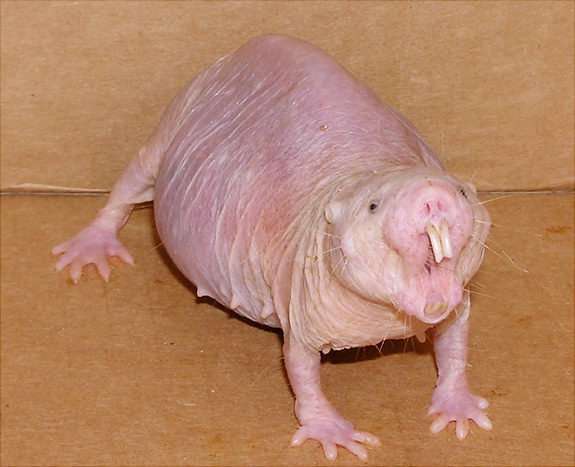January 30, 2018 report
Naked mole rat found to defy Gompertz's mortality law

A team of researchers at Google-owned Calico Life Sciences LLC has found that the naked mole rat defies Gompertz's mortality law. In their paper published in eLife, the group describes their study of the unusual-looking rodent and describe some of its unusual traits.
Naked mole rats are very nearly hairless. They evolved that way by living in a harsh underground environment. They are also almost ectothermic (cold blooded). And now, it seems they do not age—at least in the traditional sense. Reports of long-lived mole rats prompted the team at Calico to take a closer look—they have a specimen in their lab that has lived to be 35 years old. Most "normal" rats, in comparison, live to be just six years old, and they age as they do so.
Naked mole rats also have some other interesting biological features—they very rarely develop cancer, they experience very little pain and they have been found able to survive without oxygen for up to 18 minutes by going into a plant-like vegetative state. Also, they never reach menopause, and can have offspring right up until their death—and their hearts and bones never show signs of aging. But it was their longevity that was the focus of this new effort.
The team collected what they describe as 3,000 points of data regarding the lifespan of the naked mole rat, and found that many had lived for 30 years. But perhaps more surprisingly, they found that the chance of dying for the mole rats did not increase as they aged. All other mammals that have been studied have been found to conform to what is known as Gompertz's mortality law, which states that the risk of death for a typical mammal grows exponentially after they reach sexual maturity—for humans, that means the odds of dying double every eight years after reaching age 30. This, the researchers claim, suggests that mole rats do not age—at least in the conventional sense. They do eventually die, after all.
The research team concludes by suggesting that a lot more work needs to be done with naked mole rats to find out if they are aging, but are doing so very slowly. Most captive mole rats, they note, are killed for research purposes, so there is little good data on how long they actually live.
More information: J Graham Ruby et al. Naked mole-rat mortality rates defy Gompertzian laws by not increasing with age, eLife (2018). DOI: 10.7554/eLife.31157
Abstract
The longest-lived rodent, the naked mole-rat (Heterocephalus glaber), has a reported maximum lifespan of >30 years and exhibits delayed and/or attenuated age-associated physiological declines. We questioned whether these mouse-sized, eusocial rodents conform to Gompertzian mortality laws by experiencing an exponentially increasing risk of death as they get older. We compiled and analyzed a large compendium of historical naked mole-rat lifespan data with >3000 data points. Kaplan-Meier analyses revealed a substantial portion of the population to have survived at 30 years of age. Moreover, unlike all other mammals studied to date, and regardless of sex or breeding-status, the age-specific hazard of mortality did not increase with age, even at ages 25-fold past their time to reproductive maturity. This absence of hazard increase with age, in defiance of Gompertz's law, uniquely identifies the naked mole-rat as a non-aging mammal, confirming its status as an exceptional model for biogerontology.
Journal information: eLife
© 2018 Phys.org




















